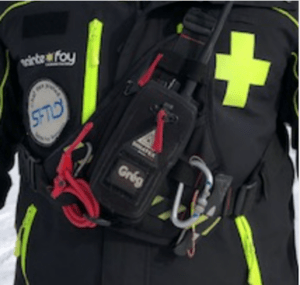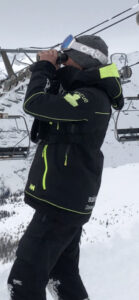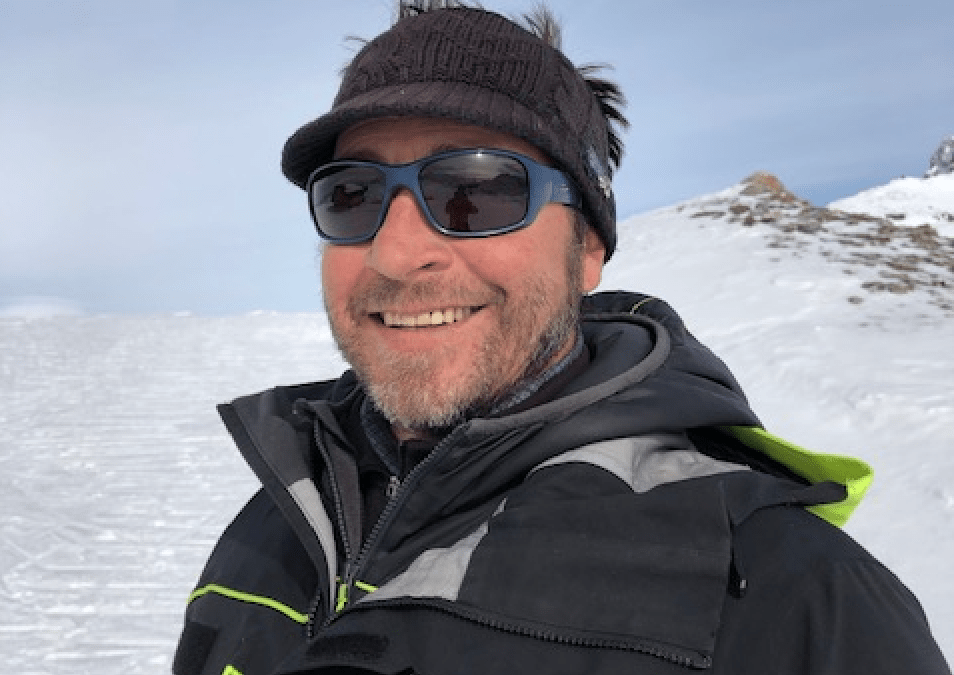Sometimes high adrenalin, sometimes high speed, sometimes enjoying the wide open spaces in the high mountains, but we can always be grateful that there is a team of highly dedicated pisteurs making the pistes as safe as they can be.
Grégory Roy is an unassuming, yet confident Chef des Pistes in Sainte-Foy-Tarentaise. A pisteur with twenty years experience, he took over this role three years ago from Nathalie Grand, after serving his time as her ‘adjoint’ (her second in command). Before her, Geoff, now running Les Marquises restaurant with his wife Nadine was the previous Chef des Pistes. Grég now heads up a team of 14 pisteurs, ten men and four women, and he is in charge of mountain safety in Sainte Foy Tarentaise.
It’s 10 o’clock in the morning as we sit down for coffee in L’à Coeur. Grég has already been busy out on the mountain, carrying out his morning safety checks of the pistes and briefing his team before coming to speak to us. He takes off his hat and places his radio transmitter on the table, as if to say “I’m always on call”.
Now living in Hauteville-Gondon, but originally from Reims in the Champagne region, Grég tells us how his parents brought him here skiing when he was a kid. At 18 he moved here to become a rafting instructor and to teach kayaking at the world renowned centre in Bourg.
He soon became a pisteur for the winter months while remaining a kayaking and rafting instructor during the summer. It wasn’t long before is main passion prevailed and he became a full time pisteur. “There’s lots to do in summer, and I really enjoy spending time in the mountains in the summer too, when they’re not covered in snow.”
On a normal day the pisteurs start at 08h10 for a quick meeting and then head up to to their part of the mountain at 08h20.
The team have to ski down all the pistes to check their condition, do a piste check, make sure that all signs are in place and that the coloured piste marker poles are upright. “We don’t want any leaning over which might skewer someone”. This is an ongoing task throughout the day, also looking out for newly exposed rocks and other dangers, but always leaving two pisteurs ‘au sommet’ of each mountain.
 146 people were rescued off the mountain in the Sainte-Foy ski area last winter season. This is the number who were given assistance, either on a ‘traîneau’, a sled dragged by one pisteur, and affectionately known as a ‘blood wagon’ and used on the piste; or a ‘barquette’ which is a sled with one pisteur in front, and another behind, and is used in off piste situations.
146 people were rescued off the mountain in the Sainte-Foy ski area last winter season. This is the number who were given assistance, either on a ‘traîneau’, a sled dragged by one pisteur, and affectionately known as a ‘blood wagon’ and used on the piste; or a ‘barquette’ which is a sled with one pisteur in front, and another behind, and is used in off piste situations.
The pisteurs only cover areas which can be accessed from the top of a lift, using gravity. If you hike up to somewhere which cannot be accessed directly from the top of a lift by gravity, you then come under the charge of the gendarmes and are more likely to be rescued by a helicopter in the case of emergency. This comes under a different level of insurance protection, and we recommend that you check your policy before venturing out of the pisteur covered areas.
One of the most important areas when it comes to skier safety in the mountains is managing the avalanche risk. It’s not an exact science, but the science is good, and the pisteurs make use of everything available to them.
All pisteurs are ‘nivologues’, specialists in the scientific study of snow and snow-related phenomena, especially avalanches. Knowledge is king, and keeping track of which direction the wind was blowing when it snowed, the temperature, and many other factors, allows the pisteurs to predict as accurately as possible where the main risks are. Grég has a talent for reading the weather and encourages this within his team. Each morning two of his team are assigned to start the day on weather duty.
 These two météo (weather) observers take measurements and recordings, and send them to Météo France in Bourg Saint Maurice, as do all the other ski stations in the area. “Météo France then judge the avalanche risk using this info, and each day they give us a ‘bulletin de risque d’avalanche’, which we put up each morning, on the notice board outside the lift office”.
These two météo (weather) observers take measurements and recordings, and send them to Météo France in Bourg Saint Maurice, as do all the other ski stations in the area. “Météo France then judge the avalanche risk using this info, and each day they give us a ‘bulletin de risque d’avalanche’, which we put up each morning, on the notice board outside the lift office”.
From a personal point of view, my dream job would be to ski around the mountain and set off avalanches, so I am eager that we move the conversation onto this part of his job. It’s no great surprise that to ‘déclenche‘ (set off) avalanches you have to be a trained ‘artificier’ (pyrotechnician), which means being trained in quarry explosives.
Still keen to know if I could make it to become a pisteur, I ask about the selection process. Grég smiles in a way that tells me this isn’t the first time he’s heard this question, and informs me that each year there are four to five assessment days with 200 candidates per day, and only 15 places available. Part of the assessment involves skiing down the piste, and being graded by the pisteurs. Candidates have to demonstrate high levels of skiing competence without being dangerous. It’s a rigorous process for a demanding job.
After big snowfalls, pisteurs really come into their own, and their days start at 3.30 am for some early morning avalanche blasting. “It is important to clear unstable snow off the slopes before skiers go there, and we do this by setting off explosions to trigger avalanches.” Each of these explosions is made using 2.8 kg of dynamite in a plastic sausage. Grég has 400kg in stock in a secret location under very high security, with video connected to the local police station.
There are sixty CATEX (CAbles for Transporting EXplosives) sites and ten sites which have to be set off manually. Manually means skinning up above the possible avalanche site, inserting a detonator into the plastic sausage of dynamite, connecting a 1m fuse, lighting it, and throwing it into the snow. It takes 90-120 secs to go bang, and the pisteurs wait to make sure this happens. The dynamite is attached to a rope in case it doesn’t go off, and in such circumstances they have to wait 30 minutes before hauling it back in and starting the process all over again. Grég shivers at the thought of 30 minutes on top of a cold exposed mountain at 4am waiting for a sausage of dynamite to not go off!
Most of the time the fuse is reliable as it is covered in a plastic sheath, so even when buried in the snow, it carries on burning. The problem only really arises if there is a manufacturing defect in the fuse.
Safety being an important part of the job I ask Grég if he wears a helmet. “Sometimes when it’s really dangerous, but most of the time, I need to have really good sensory awareness all around me, and for me, it is safer not to wear a helmet. That said, for normal skiers, it’s an important safety measure, and unfortunately we’ve seen the results of not wearing helmets.”
Guessing that after twenty years as a pisteur he must have seen everything the mountain has to offer, I ask if anything ever surprises him. Instantly he ripostes with “the New Year swimsuit parade. I expected 20 people might think it a good idea to ski down the mountain on New Year’s Day in their underwear, but there were 200!” All British he thought, as of course the French wouldn’t be so crazy! Quite taken by the spectacle, Grég is looking to assist next year, as he thought it was great publicity for the station.
Finally Grég tells us that he likes being on the mountain, especially the morning check, and the satisfaction of clearing the mountain safely after the lifts close. He’s definitely got his dream job!


